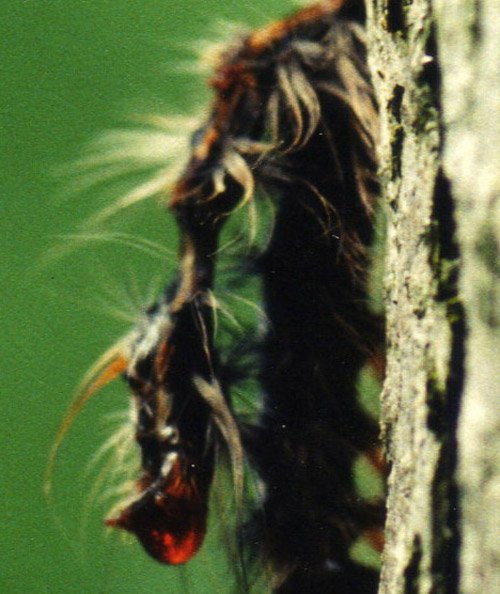Some viruses change the behavior of their host, notable examples being the zombie ants and cat-loving rodents. Another example of such a ‘mind-controlling’ virus is the baculovirus, controlling its host, the gypsy moth caterpillar. A new study has identified a single gene that enforces this control on its host.
Healthy, uninfected gypsy moths (see figure 1) usually stay close to the ground, hiding from birds and other predators. Feeding happens at night. Infected caterpillars climb to treetops in broad daylight. But that’s not all the virus does. It forces the caterpillar’s cells to make copies of themselves. The virus also produces enzymes that break down cell walls, effectively liquefying the caterpillar (see figure 2). This goo then drops down and infects other caterpillars.
Figure 1: A healthy gypsy moth caterpillar.
(Source: Wikimedia Commons, user: IronChris)

Figure 2: Liquefied caterpillar.
(Credit: Michael Grove)
The gene used by the virus to exert its control, is known as egt, which inactivates a moulting hormone. The effect of the gene was tested by infecting one group of caterpillars with the unmodified virus, one group with the virus missing the gene, and a final group infected with the virus in which the gene had been removed and reinserted. The caterpillars in the first and third group met their sticky end, while the second group lived on happily ever after.
How the gene exactly controls the behavior of its host is still not entirely clear. Nevertheless, there are already some ideas to tweak the virus’s genes to use it as pest-control, as the gypsy moth is an invasive species and pest of hardwood trees.
Reference
Hoover, K.; Grove, M.; Gardner, M.; Hughes, D.P.; Mcneil, J. and Slavicek, J. (2011). A Gene for an Extended Phenotype. Science. 333(6048), p. 1401. doi:10.1126/science.1209199.



